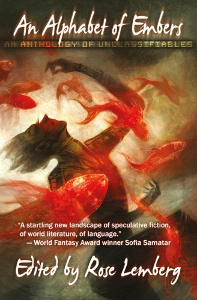 Series: Root Code, #3
Series: Root Code, #3
First Published: 21st May, 2016
Genre: Space Opera / Novel
Available: Amazon.com | Amazon UK | Riptide / Anglerfish
The rebel fleet is recovering after a major battle, but more losses are to come. This puts a strain on Adam’s relationship with his husband Lochlan. Meanwhile, Sinder has a plan to get rid of the rebels and save the Protectorate.
The book is told from the perspectives of several characters, though Adam is presented as the main protagonist. Adam is a former member of the Protectorate. Lochlan is from the Bideshi, a group of space nomads. The rebels are made up of a mixture of both. Previously, Adam had been accepted by the Bideshi and trained by their Aalim (people with powers) to use his own powers.
The core of the story focuses on character relationships. A lot of time is spent recovering from attacks, with the tensions that arise when the initial rush of action is over. I liked the general idea of that, but I wish it hadn’t mainly been romantic relationships. Friendships and other family relationships were pushed to the side, such as someone’s children being conveniently absent and only mentioned in passing. It was that odd feeling of a community made up of a series of couples, rather than having a range of relationships.
I did like the political elements, as both sides have to make alliances and plan strategies. Sinder’s sections were particularly good for this, as it explores the ways he convinces himself the end justifies the means. He enlists the help of Julius, an exiled Bideshi, and tries to ignore that there might be very good reasons for the exile.
The worldbuilding had some elements with potential. Bideshi ships have a forest inside and an alien race appears briefly. Those things didn’t appear as more than background detail though.
The characters are various races, such as Lochlan and others of the Bideshi being black, though culturally things are pretty Western. The story of Abraham is told in detail and Western history is remembered. But other cultures are down to a few names and a forgotten statue. The main relationship is two men, though the other relationships are men and women. So there’s some diversity, but not perhaps as much as I’d hoped.
Some areas aren’t handled well at all. The Aalim are blind, which is connected to their abilities. It uses the common trope of them having magical sight. Their blindness was also constantly reinforced, in a way that felt very othering. The characters couldn’t appear without some reference to them being blind. Their eyes were blind eyes. When they looked at things, it was emphasised that they weren’t really looking, because they were blind.
Julius is albinistic. He’s described as having unnaturally pale skin, and that it’s disturbing when he’s dressed in white as that matches his skin. It could be argued this is from Sinder’s perspective, but the narrative also reinforces it as being true. Julius has supernatural abilities gained through violent means (some of which is shown graphically). He’s portrayed as an irredeemable monster. This falls into the stereotype of the evil albino, with a side helping of blaming his evil on insanity.
There were other things that didn’t work for me, like describing Adam using his abilities as though it was rape, Lochlan almost hitting Adam, and the general white saviour feel of Adam’s story.
It’s not a bad science fiction story. I liked the political parts and the interactions between the antagonists. It could appeal to someone who likes a strong focus on romantic relationships during difficult times. But the parts that didn’t work for me really didn’t, to the point of putting the book down for long periods.
[A copy of this book was received from the publisher for review purposes]
 First Published: 6th July, 2016
First Published: 6th July, 2016 Developer: The Fullbright Company
Developer: The Fullbright Company Collection: Solitary Travelers
Collection: Solitary Travelers Collection (First Edition Only): Solitary Travelers
Collection (First Edition Only): Solitary Travelers